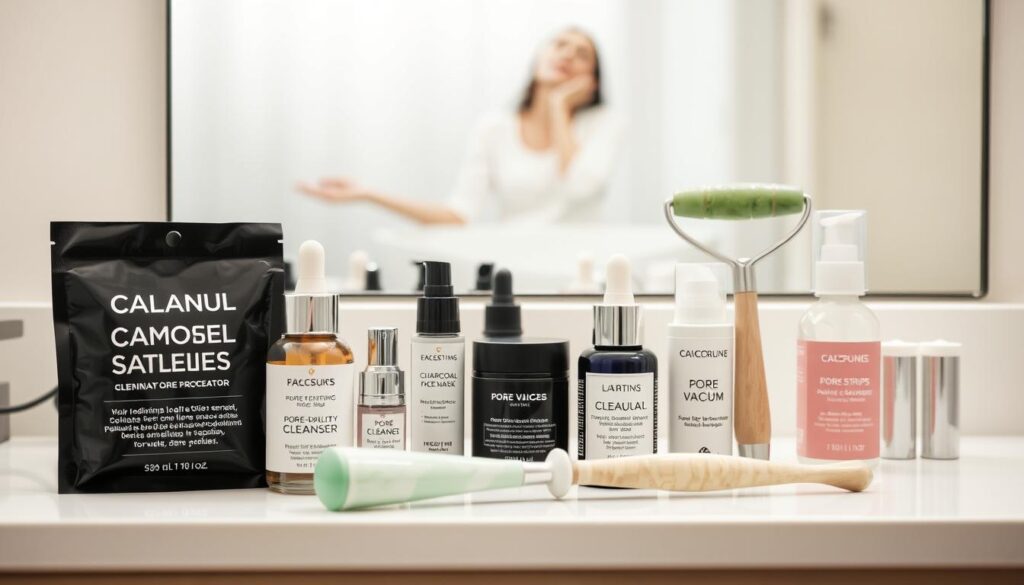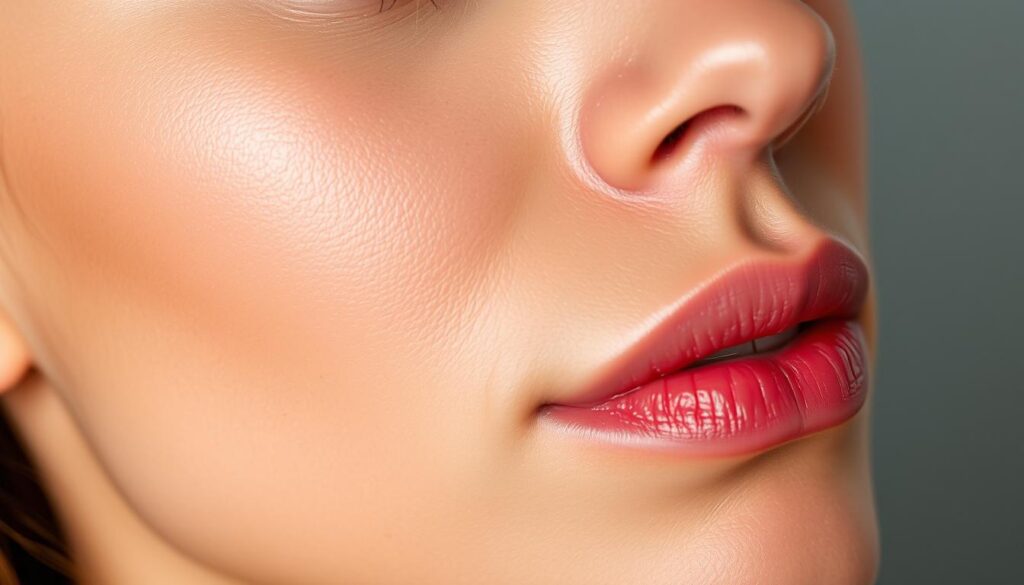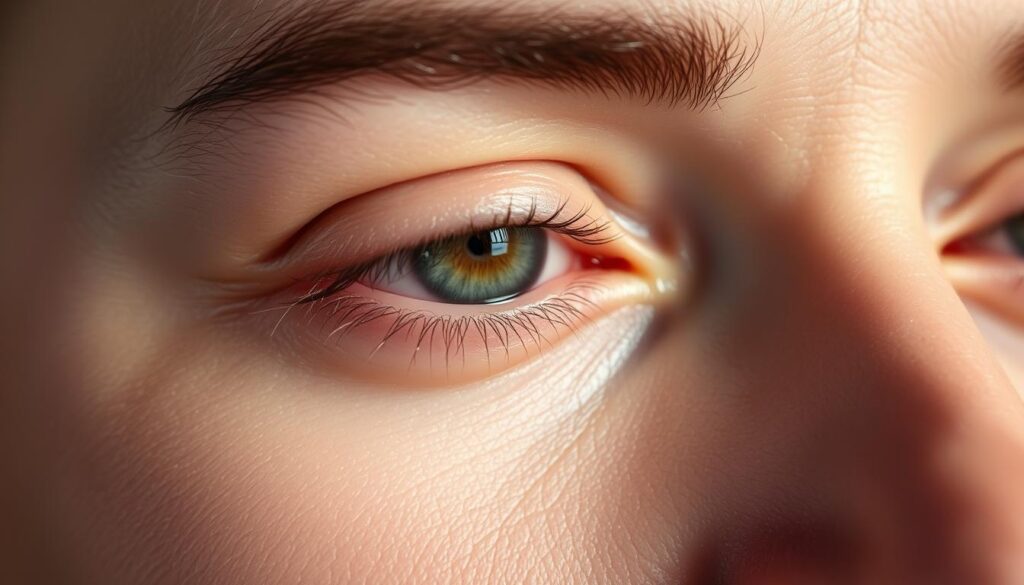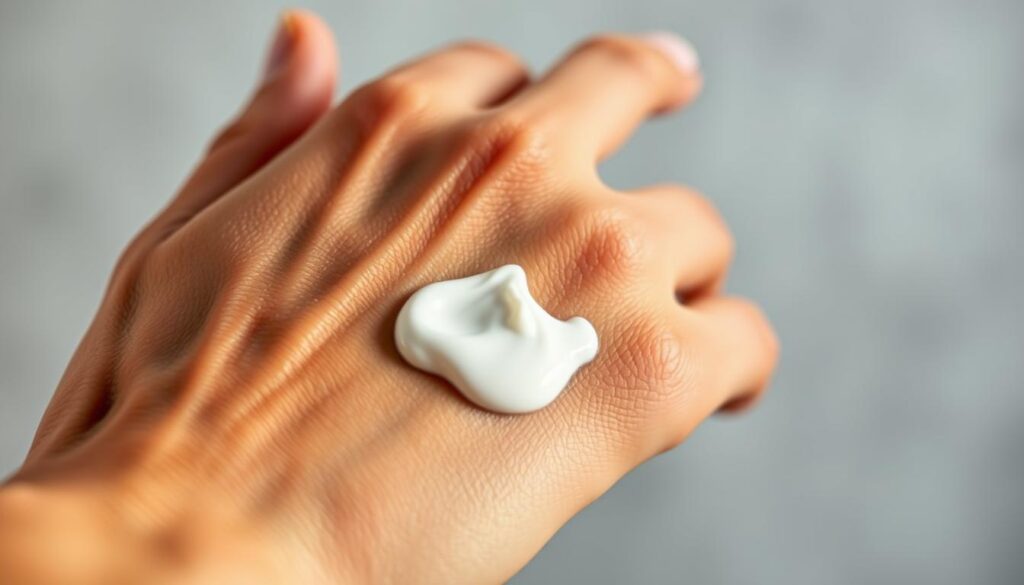Pores are tiny openings in your skin that play a vital role in secreting sebum and sweat. While they are essential for healthy skin, their appearance can sometimes be a cosmetic concern. Factors like genetics, oil production, and sun exposure can influence how noticeable they are1.
As you age, your skin loses elasticity, which can make pores appear larger2. Hormonal changes, especially in women, can also affect their size3. While you can’t permanently shrink pores, you can take steps to minimize their visibility. This includes using the right cleanser and incorporating skin care products like clay masks into your routine1.
Understanding these factors can help you develop a routine that keeps your skin looking its best. Whether you’re dealing with excess oil or sun damage, there are ways to improve the appearance of your pores and maintain healthy skin.
Basics of Skin Pores and Their Function
Your skin is home to small openings called pores, which play a key role in its health. These tiny structures allow your body to release sweat and oils, keeping your skin hydrated and balanced1.
What Are Pores and How They Work
Pores are connected to hair follicles and sebaceous glands, which produce sebum, a natural oil that moisturizes your skin. This process helps protect your skin from dryness and external irritants4.
When your glands produce too much oil, it can mix with dead skin cells and dirt, potentially clogging your pores. This can make them appear larger and more noticeable1.
Types of Pores and Their Role in Skin Health
There are two main types of pores: those that release sweat and those that secrete oil. Sweat pores help regulate body temperature, while oil pores keep your skin soft and supple4.
Proper skin care is essential to maintain healthy pores. Using gentle cleansers and exfoliating regularly can prevent blockages and keep your skin looking its best1.
Enlarged Pores: What Causes Them and How to Minimize
Your skin’s health depends on tiny structures called pores, which play a vital role in its balance. These small openings help release sebum, a natural oil that keeps your skin hydrated. However, factors like genetics, oil production, and aging can make them more noticeable5.
Understanding Sebum, Elasticity, and Genetics
Excess sebum production is a primary cause of enlarged pores. When your oil glands are overactive, they can stretch the pore openings, making them appear larger6. Aging also plays a role, as your skin loses elasticity over time, reducing its ability to bounce back5.
Genetics determine your pore size and skin type. If your family has a history of oily or acne-prone skin, you’re more likely to experience enlarged pores5.
External Factors and Lifestyle Influences
Environmental factors like sun exposure and pollution can worsen the appearance of pores. UV rays break down collagen, leading to sagging skin and more visible pores6.
Lifestyle choices, such as diet and stress, also impact your skin. High sugar intake and lack of hydration can increase oil production, while stress triggers hormonal changes that affect your pore size5.
By understanding these factors, you can take steps to improve your skin care routine and minimize the appearance of pores.
Effective At-Home Pore Minimizing Techniques
Maintaining healthy skin starts with understanding how to care for its natural openings. With the right routine, you can improve the appearance of your pore size and keep your skin looking fresh and balanced.
Gentle Cleansing and Noncomedogenic Skincare
Start your day with a gentle cleanser to remove excess oil and dirt. Washing twice daily helps prevent clogged pores and keeps your skin clear7. Opt for water-based, noncomedogenic products to avoid further blockages8.
Using gel-based cleansers is particularly effective for those with oily skin. These products help clear oil without stripping your skin of its natural moisture7.
Exfoliation, Clay Masks, and Hydration Routines
Exfoliating once or twice a week removes dead skin cells, preventing them from clogging your pores. Products with beta hydroxy acids are excellent for this purpose8.
Incorporate a clay mask into your routine to absorb excess oil. Studies show that using these masks twice a week can significantly improve the appearance of your skin7.

Incorporating Salicylic Acid and Retinol Treatments
Salicylic acid is a powerful ingredient for unclogging pores. It penetrates deep into the skin to remove impurities and reduce their size8.
Retinol treatments can also help by promoting cell turnover and improving skin texture. Start with a low concentration to avoid irritation and gradually increase usage7.
| Product Type | Benefits | Frequency |
|---|---|---|
| Gentle Cleanser | Removes dirt and oil | Twice daily |
| Clay Mask | Absorbs excess oil | 1-2 times weekly |
| Salicylic Acid | Unclogs pores | As needed |
| Retinol | Improves skin texture | 2-3 times weekly |
Consistency is key to seeing results. Stick to your routine, and over time, you’ll notice a smoother, more refined skin texture.
Professional Treatments and Dermatologist Insights
When at-home methods fall short, professional treatments provide a reliable alternative. These advanced solutions target stubborn concerns like enlarged pores and uneven texture, offering long-lasting results9.
Microneedling, Chemical Peels, and Laser Therapies
Microneedling creates micro-injuries in the skin, stimulating collagen production and improving elasticity. This process helps reduce the appearance of pores and fine lines10.
Chemical peels use acids like glycolic or salicylic to resurface the skin. They remove dead skin cells and unclog pores, leaving your face smoother and brighter9.
Laser therapies target deeper layers of the skin, promoting collagen synthesis. Non-ablative lasers are particularly effective for refining skin texture without damaging the surface10.
When to Consult a Dermatologist for Advanced Care
If your skin concerns persist despite at-home efforts, it’s time to see a dermatologist. They can assess your condition and recommend tailored treatments9.
Overusing at-home products can sometimes worsen issues like excess oil production or irritation. A professional ensures safe and effective care10.
| Treatment | Benefits | Frequency |
|---|---|---|
| Microneedling | Boosts collagen, reduces pores | Every 4-6 weeks |
| Chemical Peels | Resurfaces skin, unclogs pores | Every 2-4 weeks |
| Laser Therapy | Improves texture, minimizes pores | Every 6-8 weeks |
Professional treatments offer a powerful way to achieve smoother, healthier skin. Consulting a specialist ensures you get the best results for your unique needs.
Special Focus: Minimizing Nose Pores
The nose area often requires extra attention due to its unique skin structure. Its naturally larger pores and higher sebum production make it more prone to clogging and visibility11. By adopting targeted strategies, you can improve its appearance and maintain healthy skin.
Daily Maintenance and Makeup Removal Strategies
Start by thoroughly removing makeup before bed. Leftover residue can mix with oil and dead skin cells, leading to blockages12. Use a gentle cleanser designed for your skin type to ensure a clean base.
Incorporate a double-cleansing method if you wear heavy makeup. This involves using an oil-based cleanser first, followed by a water-based one. It effectively removes debris without stripping your skin of its natural moisture11.
Deep-Cleansing and Targeted Clay Mask Approaches
Weekly deep-cleansing routines are essential for the nose area. Apply a clay mask specifically to this zone to absorb excess oil and impurities12. Leave it on for 10-15 minutes before rinsing off for a refreshed feel.
Exfoliate gently once or twice a week to remove dead skin cells. Avoid over-exfoliating, as it can irritate the skin and worsen the appearance of pores11.
| Step | Product | Frequency |
|---|---|---|
| Makeup Removal | Oil-based cleanser | Daily |
| Cleansing | Water-based cleanser | Twice daily |
| Deep Cleansing | Clay mask | 1-2 times weekly |
| Exfoliation | Gentle scrub | 1-2 times weekly |
Consistency is key to seeing results. Stick to your routine, and over time, you’ll notice a smoother, more refined skin texture on your nose area.
Conclusion
Achieving smoother skin is possible with the right care and consistency. While genetics influence pore size, proper routines can make a noticeable difference. Gentle cleansing and exfoliation help remove excess oil and impurities, improving their appearance13.
Regular use of clay masks and targeted treatments like salicylic acid can further refine texture14. For persistent concerns, professional options like chemical peels or laser therapy offer advanced solutions15.
Consistency is key. Stick to your routine and consult a dermatologist if needed. With these steps, you can enjoy a clearer, healthier complexion.



